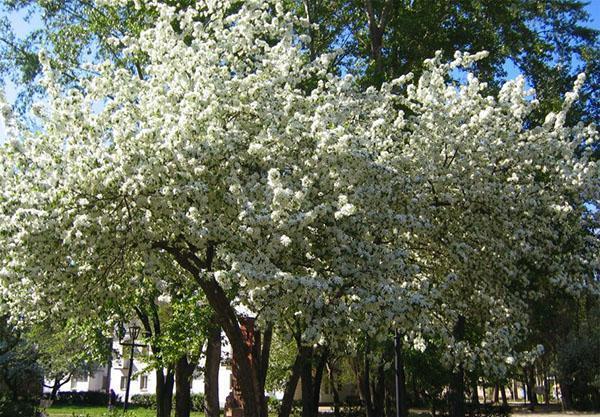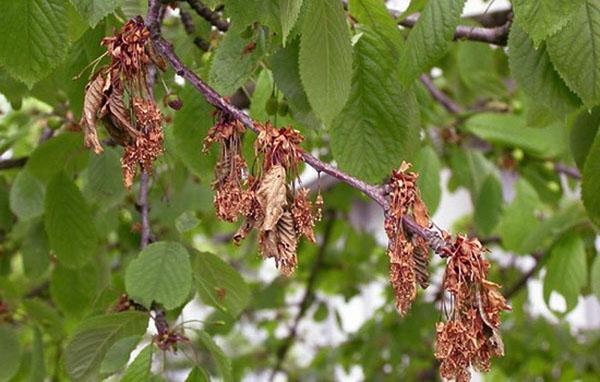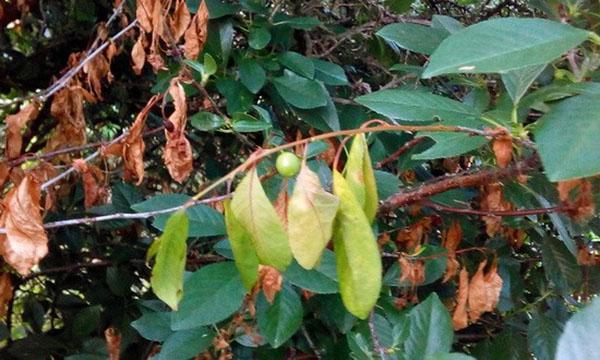Why does cherry dry after flowering and how to save a tree
 The question of why cherry dries after flowering does not have a clear answer. It is believed that wild flowering weakens the tree and reduces its resistance to ailments. On the other hand, it has been noticed that the abundant flowering of one specimen compared to the rest is a signal of illness, and the last effort to prolong life by creating many seeds. Often, improper agricultural practices are the root cause of the disease.
The question of why cherry dries after flowering does not have a clear answer. It is believed that wild flowering weakens the tree and reduces its resistance to ailments. On the other hand, it has been noticed that the abundant flowering of one specimen compared to the rest is a signal of illness, and the last effort to prolong life by creating many seeds. Often, improper agricultural practices are the root cause of the disease.
Prerequisites for the disease

The cherry dries, what should I do? Any incomprehensible yellowing, drying out does not occur spontaneously, this is a sign of a disease, most likely fungal. An old unkempt garden becomes a breeding ground for many diseases. Gradually, they are spread by insects and wind to neighboring plantations.
If there are prerequisites, it is necessary to carry out preventive measures more often. But any processing should be stopped 20 days before picking berries.
Disease prevention
 Cultivated plants can be healthy only if agricultural technology is observed. Timely treatment of cherry trees and shrubs from pests and diseases will destroy the infection in the bud.
Cultivated plants can be healthy only if agricultural technology is observed. Timely treatment of cherry trees and shrubs from pests and diseases will destroy the infection in the bud.
A tree that receives good nutrition will be strong, there will be enough health reserves for flowering and pouring berries without harm to the crown. The resulting lesions on the bark must be examined, disinfected and repaired immediately. It is easier to prevent an infection than to treat it with far from harmless methods. Why doesn't a neighbor's cherry dry after flowering?
The answers are simple:
- The tree is planted on a hill or slope, well ventilated.
- The seedling was purchased from a breeding station of a variety resistant to moniliosis.
- Trees are whitewashed annually, not only trunks, but skeletal branches. Each crack in the bark is disinfected and sealed with garden varnish so that spores have nowhere to settle.
- The leaves are collected, the trunk circles are well-groomed.
- The branches are thinned according to the principle - the sparrow will fly by.
Despite the tightness of the summer cottage, the cherry should have a sufficient food area.
In order for the cherry to delight in color and an abundance of healthy berries, the tree should be properly planted and watered on time. Cherry does not like waterlogging and deep planting, the roots can rot.
 Spraying at a certain time is carried out as a prophylaxis against fungal diseases that are introduced:
Spraying at a certain time is carried out as a prophylaxis against fungal diseases that are introduced:
- into the open tubule of the flower;
- in a fresh wound on a broken branch;
- crack in the bark.
The disease has penetrated into the flowers and twigs, which is why the cherry dries after flowering.
Spores, bacteria, insect pests develop in a natural cycle. Therefore, it is impossible to treat plants with drugs, as it turns out, there is a schedule:
- immediately after the snow melts, treat the trunks and trees with a 3% solution of Bordeaux liquid or Bordeaux mixture "Extra";
- spraying with a 1% solution of copper sulfate on a green cone;
- before flowering, cherries should be treated with Horus from moniliosis;
- during the growing season, do preventive treatments with Abiga-peak, But, Topsin, Horus.
Fungal diseases are introduced during the damp and cold season, with prolonged flowering. It is necessary to take preventive measures, guided by the weather, without missing a favorable time.
Signs of disease when cherry dries after flowering
 The thunderstorm of modern cherry orchards was the moniliosis disease, imported from America. It is a fungal disease on flowers in spring and on fruits before harvest. A sign of spring infection - cherry leaves dry after flowering, branch necrosis occurs. At this time, the mycelium quickly penetrates inside and infects the entire tree. You can determine moniliosis by finding a dark ring on the cut of the branch.
The thunderstorm of modern cherry orchards was the moniliosis disease, imported from America. It is a fungal disease on flowers in spring and on fruits before harvest. A sign of spring infection - cherry leaves dry after flowering, branch necrosis occurs. At this time, the mycelium quickly penetrates inside and infects the entire tree. You can determine moniliosis by finding a dark ring on the cut of the branch.
The only correct solution would be to cut off all branches 5-15 cm further than the place of visible drying out and burn all plant debris. During the summer, the tree should be watched and dried branches should be removed. Having destroyed the outbreak, the next year, prevention should be carried out on schedule.
 The fruits remaining on the branches in the places of insect bites form gray spore-bearing pads. They are located chaotically, and this is different from gray fruit rot. Mummified fruits, fallen leaves will become a source of infection for the next year. If the disease is running, gray growths will appear on the bark.
The fruits remaining on the branches in the places of insect bites form gray spore-bearing pads. They are located chaotically, and this is different from gray fruit rot. Mummified fruits, fallen leaves will become a source of infection for the next year. If the disease is running, gray growths will appear on the bark.
It is important that neighboring plantations are also attentive to the eradication of the infection. The disease itself will not go away, the tree will completely destroy. Systemic fungicides have no effect on spores of the fungus Monilia cinerea.
Clasterosporium or spotting is also the reason why cherry leaves dry. The disease manifests itself throughout the tree, including the roots. In this case, the buds of flowers and leaves turn black, fall off, the leaves become like a sieve. The cherries remaining on the branches are mummified and become carriers of spores. The mycelium is destroyed by copper oxychloride and Bordeaux mixture.
 Coccomycosis - the fungus actively multiplies after the flowering of the tree, which is why the cherry dries. Signs of infection are red dots on the top of the leaves, and pink spores can be found on the back. The leaves turn yellow, fall off, the berry filling stops. If signs of coccomycosis are found, the harvest of the current year will have to say goodbye. A tree in bloom must be treated with a 3.5% solution of copper sulfate. If the harvest continues, after picking the berries, treatment with Horus should be carried out. Shed the soil with a solution of urea at the rate of 40 grams per 1 liter.
Coccomycosis - the fungus actively multiplies after the flowering of the tree, which is why the cherry dries. Signs of infection are red dots on the top of the leaves, and pink spores can be found on the back. The leaves turn yellow, fall off, the berry filling stops. If signs of coccomycosis are found, the harvest of the current year will have to say goodbye. A tree in bloom must be treated with a 3.5% solution of copper sulfate. If the harvest continues, after picking the berries, treatment with Horus should be carried out. Shed the soil with a solution of urea at the rate of 40 grams per 1 liter.
Only by carrying out a set of measures to preserve a healthy garden can you reduce losses from fungal diseases.